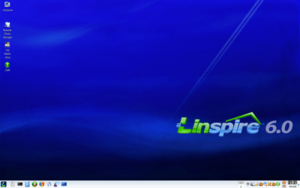Linspire facts for kids

A look at the Linspire desktop
|
|
| Company / developer | PC/OpenSystems LLC |
|---|---|
| OS family | Linux (Unix-like) |
| Working state | Active |
| Source model | Mixed (open and closed source) |
| Initial release | August 2001 |
| Latest stable release | 14 / December 18, 2023 |
| Update method | CNR |
| Kernel type | Monolithic (Linux) |
| Default user interface | GNOME, Xfce |
| License | Mainly GNU GPL and other free software licences; as well as some proprietary software licenses. |
| Official website | linspirelinux.com |
Linspire is a computer operating system based on the popular Linux system. Think of an operating system as the main software that runs a computer, like Microsoft Windows or Apple's macOS. Linspire was first known as Lindows.
The company that makes Linspire has changed over the years. It was first owned by Linspire, Inc., then by a company called Xandros, and now it is owned by PC/OpenSystems LLC.
In 2008, the Linspire brand was briefly discontinued. However, in 2018, PC/OpenSystems LLC bought the name and brought it back. Today, you can buy the latest version of Linspire, or you can download its free sister version, Freespire.
Contents
History of Linspire
The story of Linspire begins in 2001 in San Diego, California. A company called Lindows, Inc. was started by Michael Robertson. His big idea was to create a Linux-based operating system that could also run popular Microsoft Windows programs.
The Lawsuit with Microsoft
In 2002, the giant tech company Microsoft sued Lindows, Inc. Microsoft argued that the name "Lindows" was too similar to its famous "Windows" trademark and would confuse people.
The court, however, pointed out that Microsoft itself had used the word "windows" to describe computer screens before its operating system was famous. After more legal discussions, the two companies decided to settle the case in 2004.
As part of the deal, Microsoft paid Lindows, Inc. about $20 million. In return, Lindows, Inc. changed its name to Linspire, Inc. and gave the "Lindows" trademark to Microsoft.
Changes in Ownership
Linspire has been owned by a few different companies.
- Linspire, Inc. (2001-2008): The original company that created Lindows and Linspire.
- Xandros (2008-2017): This company bought all of Linspire's assets. For a while, they stopped making Linspire and focused on their own products.
- PC/OpenSystems LLC (2018-Present): This company bought Linspire and its free version, Freespire. They brought the operating system back, and it is still being developed today.
Working with Other Companies
Over the years, Linspire has worked with other major tech companies. In 2007, Linspire announced a partnership with Canonical Ltd., the company that makes the Ubuntu operating system. This meant that future versions of Linspire would be based on Ubuntu's technology.
That same year, Linspire also made an agreement with Microsoft. The goal was to make it easier for Linspire and Windows to work together, especially with things like documents, instant messaging, and digital media.
What was CNR?
Linspire created a special service called CNR, which stood for "Click'N'Run." Think of it as an early version of an app store. It was designed to make getting new software for your computer super easy.
With just one click, users could download and install all kinds of applications. Some programs were free, while others were commercial software that you could buy at a discount. At one point, CNR had over 38,000 different software packages available.
Originally, you had to pay a yearly fee to use CNR. But in 2006, Linspire made the basic service free for everyone. The company even planned to make CNR available for other Linux systems like Ubuntu and Fedora.
Freespire: The Free Version
In 2006, Linspire announced a project called Freespire. It was a free, community-supported version of the main Linspire operating system. This is similar to how some companies offer both a professional version of their software and a free version with slightly fewer features.
Freespire included many of the great things from Linspire, like the CNR service. However, it also had a special "OSS Edition" that only included open-source components, which are programs that anyone can view, share, and modify for free.
The first version of Freespire was released in 2006. After a few updates, the project was paused when Xandros bought the company. But just like Linspire, Freespire was brought back in 2018 and is still available as a free download today.
Linspire's Help for Open Source
Linspire, Inc. did more than just make its own software. The company also supported many other open-source projects that everyone can use.
Some of the projects they helped include:
- Pidgin and Kopete: Instant messaging programs that let you talk to friends on different chat networks.
- Mozilla Firefox: The popular web browser.
- Nvu: A program for building websites.
The company also hosted events for software developers, helping people from all over the world come together to improve Linux and open-source software.
See also
 In Spanish: Linspire para niños
In Spanish: Linspire para niños
- Commercial use of copyleft works
- Zorin OS, Linux Mint, MX Linux, free Linux distributions designed to imitate Windows or recommended for longtime Windows users


